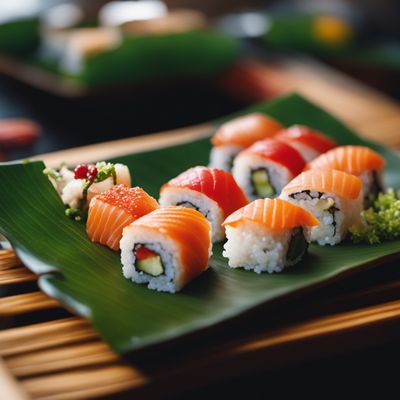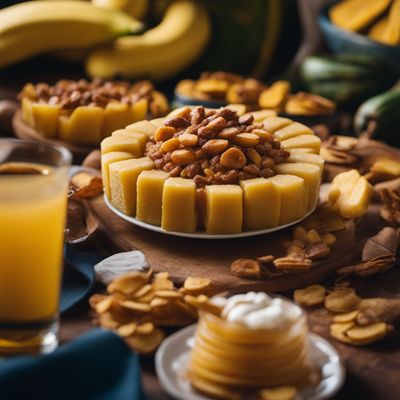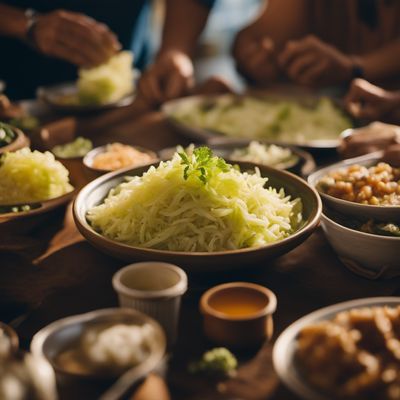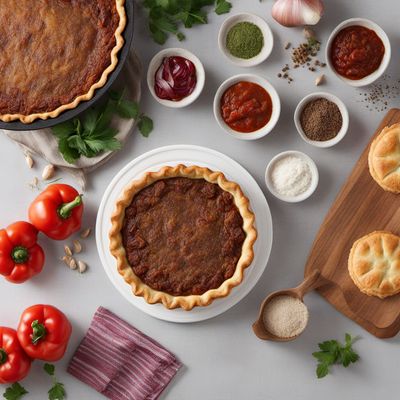
Recipe
Central American Nerikiri Delight
Tropical Nerikiri Paradise: A Central American Twist on a Japanese Delicacy
4.6 out of 5
Indulge in the vibrant flavors of Central America with this unique adaptation of the traditional Japanese dessert, Nerikiri. This recipe combines the delicate artistry of Japanese confectionery with the tropical ingredients and flavors of Central America.
Metadata
Preparation time
30 minutes
Cooking time
0 minutes (no cooking required)
Total time
30 minutes
Yields
6 servings
Preparation difficulty
Medium
Suitable for
Vegetarian, Vegan (if using vegan-friendly food coloring), Gluten-free (check the labels of the ingredients to ensure they are gluten-free), Nut-free, Dairy-free
Allergens
None (unless specific ingredients contain allergens, please check labels)
Not suitable for
Paleo, Keto, Low-carb, High-protein, High-fat
Ingredients
In this Central American adaptation of Nerikiri, we incorporate ingredients and flavors commonly found in Central American cuisine. The traditional Japanese ingredients like sweet bean paste are replaced with tropical fruits such as pineapple and passion fruit. The delicate shapes and designs of the confectionery are inspired by Central American motifs, adding a unique touch to the dessert. We alse have the original recipe for Nerikiri, so you can check it out.
-
2 cups (240g) glutinous rice flour 2 cups (240g) glutinous rice flour
-
1 cup (240ml) coconut milk 1 cup (240ml) coconut milk
-
1/2 cup (100g) granulated sugar 1/2 cup (100g) granulated sugar
-
1/4 cup (60ml) passion fruit juice 1/4 cup (60ml) passion fruit juice
-
1/4 cup (60ml) pineapple juice 1/4 cup (60ml) pineapple juice
-
Food coloring (optional) Food coloring (optional)
-
Assorted tropical fruits for garnish (e.g., mango, kiwi, papaya) Assorted tropical fruits for garnish (e.g., mango, kiwi, papaya)
Nutrition
- Calories (kcal / KJ): 180 kcal / 753 KJ
- Fat (total, saturated): 4g, 3g
- Carbohydrates (total, sugars): 35g, 15g
- Protein: 2g
- Fiber: 1g
- Salt: 0.01g
Preparation
-
1.In a mixing bowl, combine the glutinous rice flour, coconut milk, and sugar. Mix well until a smooth dough forms.
-
2.Divide the dough into two equal portions. Add passion fruit juice to one portion and pineapple juice to the other. Knead each portion until the juice is fully incorporated and the dough becomes pliable.
-
3.If desired, add a few drops of food coloring to each portion to enhance the vibrant colors.
-
4.Take a small portion of each colored dough and shape it into various Central American-inspired designs, such as tropical flowers, palm leaves, or geometric patterns.
-
5.Garnish the Nerikiri with assorted tropical fruits for an extra burst of flavor and visual appeal.
-
6.Serve chilled and enjoy the tropical delight of Central American Nerikiri.
Treat your ingredients with care...
- Coconut milk — Use full-fat coconut milk for a rich and creamy texture.
- Glutinous rice flour — Make sure to use glutinous rice flour specifically, as it provides the desired sticky consistency.
Tips & Tricks
- To achieve vibrant colors, use natural food coloring made from fruits or vegetables.
- Experiment with different tropical fruits for the garnish to add variety and enhance the flavors.
- If the dough becomes too sticky, lightly dust your hands with glutinous rice flour while shaping the Nerikiri.
Serving advice
Serve the Central American Nerikiri Delight as a delightful dessert after a Central American-inspired meal. It can also be enjoyed as a standalone treat during special occasions or celebrations.
Presentation advice
Arrange the intricately shaped Nerikiri on a beautiful platter, allowing the vibrant colors and tropical fruit garnish to create an eye-catching display. Consider using Central American-inspired tableware or decorations to enhance the overall presentation.
More recipes...
For Japanese cuisine » Browse all
More Japanese cuisine dishes » Browse all

Kimo yakitori
Chicken liver skewers
Kimo yakitori is a Japanese dish made with grilled chicken liver.

Oshizushi
Oshizushi is a type of sushi that is pressed into a rectangular shape using a wooden mold called an oshibako. It is a popular dish in Japan and is...

Bento
Bento is a traditional Japanese meal that consists of a single-portion meal served in a box-shaped container. It typically includes rice, fish or...
More Central American cuisine dishes » Browse all

Zompopos de mayo
Mayan Worms
Zompopos de mayo is a traditional dish from Nicaragua made from leafcutter ants. It is a popular snack food in Central America and is often served...

Plátanos en tentacion
Plátanos en tentacion is a traditional Latin American dessert that consists of ripe plantains cooked in a sweet syrup made with brown sugar,...

Curtido
Fermented cabbage relish
Curtido is a traditional Salvadoran relish made from cabbage, carrots, onions, and vinegar. It is a popular condiment in Central America and is...









